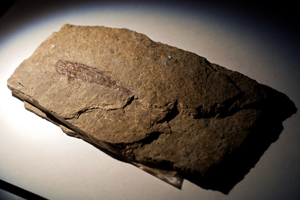Citations
By Brooke E. O'Neill, AM'04
Photography by Jason Smith

Ray-finned "Oxypteriscus" is an early complete fossil from after Hangenberg.
Fish tales
During the Devonian Period, 416 to 359 million years ago, before dinosaurs, jawed fish called placoderms and lobe-finned creatures roamed the waters, outnumbering ray-finned fish and four-legged vertebrates called tetrapods. This era of aquatic biodiversity came to an end when a mysterious extinction event known as Hangenberg dramatically altered the evolutionary landscape. The surviving species-placoderms died while ray-finned breeds persisted-became the ancestors of today's vertebrates, including humans, report Chicago graduate student Lauren Sallan, SM'09, and professor of organismal biology and anatomy Michael Coates. Just prior to the extinction, tetrapods took their first steps onto land, only to be followed by a 15-million-year stretch when they were nearly absent from the fossil record. In the May 17 Proceedings of the National Academy of Sciences, the researchers suggest the gap was fall-out from the extinction. Once tetrapods recovered, however, they began to proliferate, giving birth to five-digit limbs and other characteristics recognizable in modern mammals.
Cell destructions gone awry
When a cell becomes sick or damaged, internal mechanisms initiate self-destruction. Known as apoptosis, this cell suicide helps prevent cancerous growths. Normally, specific proteins start the process by activating a "death receptor" called CD95. Researchers have hypothesized that loss of these receptors may play a role in tumor formation, weakening the body's ability to eliminate malfunctioning cells. Several experiments were conducted in the hope of using CD95 as a cancer treatment. Yet new evidence suggests the receptor may actually encourage tumor development. When Chicago and Northwestern researchers, including Ernst Lengyel, associate professor of gynecologic oncology, eliminated or reduced CD95 in cancerous human and mouse cells, they found that malignant growth slowed considerably or completely stopped. The reason, they argue in the May 27 Nature, is that CD95's function appears to switch from death-inducing to growth-promoting, thus encouraging cancer-cell propagation.
Cost of admission
Unless U.S. museums attract more diverse audiences, they may face extinction, warns a May report from the University's Cultural Policy Center, which researches the arts and cultural heritage. The overview study examined demographic shifts and data on museum use by ethnicity and age. "Young people live today in a world that is dominated by racial, ethnic, and multicultural diversity and more global perspectives," writes center executive director Betty Farrell. Minority groups make up 34 percent of the population, yet represent only 9 percent of museum-goers. Meanwhile, core audiences are between ages 45 and 54. To remain viable, cultural institutions must adapt to the changing landscape driven not only by growing immigrant populations, but also the rise of tech-savvy generations seeking a more interactive experience.
Make the grade
For the past three decades, Chicago Public Schools (CPS) has evaluated teachers using a checklist system that placed nearly everyone within the two highest rankings. To better distinguish superior from poor performance, CPS launched the Excellence in Teaching Project, a rigorous pilot evaluation program. An overview of the project's first year (2008-09), released in June by the University's Consortium on Chicago School Research, found that 8 percent of teachers in 43 pilot elementary schools were deemed unsatisfactory (defined as "doing harm to students"), compared with only 0.3 percent of instructors under the old ratings. Researchers also confirmed evaluators used the new ratings system in a consistent manner, suggesting it could be a fair means of making hiring and firing decisions.
Return to top
